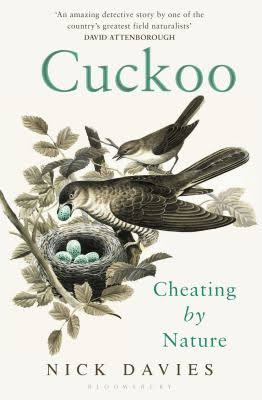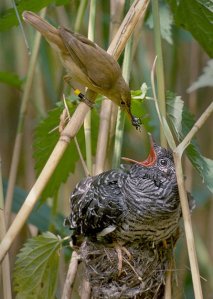I’ve just finished a fascinating book which has been sitting untouched on my bedside table for some time – another recommendation from my good friend Sue, I suspect. It somehow seems appropriate as we wait for spring.

‘Cuckoo, Cheating by Nature’ is Nick Davies’ beautifully-written account of 30 years spent observing and experimenting on the cuckoos which parasitise reed warbler nests on Wicken Fen in Cambridgeshire, unravelling the evolution of their odd lifestyle. Everyone knows that cuckoos lay their eggs in the nests of other bird species and persuade those birds to raise their chicks for them, at the expense of their own brood. But how on earth do they manage such a trick?
Davies, of course, is the latest in a long and prestigious line of naturalists to be fascinated by the cuckoo’s behaviour; in 1859, in On the Origin of Species, Darwin proposed that cuckoos somehow tricked host birds, by taking advantage of their ‘mistaken instincts’, into raising cuckoo young. He argued that the behaviour of both host and parasite had evolved by natural selection. The advantages for the cuckoo are obvious – it can migrate earlier to its winter feeding grounds if not burdened by having to raise young and the saved resources will allow it to lay more eggs, improving its chances of reproductive success. However for the host bird to survive as a species, it has to ensure not all nests are parasitised by cuckoos so that sufficient of its own young survive to reproduce. How is this balance maintained?
Darwin’s vision of an ‘entangled bank’, where species are continuously evolving to maintain their competitive position with respect to their neighbours can be seen as having led to an ‘evolutionary arms race’ between the cuckoo and its hosts. Davies has sought to understand this process using an intriguing series of field experiments based on the used of mock eggs and model cuckoos, causing plenty of amusement and bemusement amongst those who have seen him out and about ‘laying’ his model eggs.
Female cuckoos lay a single egg into a host’s nest, often removing a host egg to disguise the new addition. When the cuckoo chick hatches it grows quickly, soon outstripping its fellow nestlings. Whilst just a few days old, the cuckoo heaves any unhatched eggs and the smaller host chicks out of the nest, one by one, to secure its food supply. With the host parents’ undivided attention, the cuckoo chick soon grows to be much larger than the birds feeding it.

Reed warbler feeding a cuckoo chick. Image: Per Harald Olsen, via Wikimedia commons.
Of course, there is more to this than first meets the eye. The cuckoo has to avoid its egg being rejected by the host. Separate races of common cuckoos (Culculus canorus) produce differently coloured and patterned eggs, which generally match those of the host bird. Reed warblers lay spotted, greenish eggs and so do the cuckoos which parasitise their nests, however cuckoos which lay in their eggs in pied wagtail nests produce paler grey, finely-speckled eggs.

Reed warbler (Acrocephalus scirpaceus) nest. Image: Nottsexminer via Wikimedia commons.
Both reed warblers and the cuckoos Davies studies migrate to Africa in winter, returning in April to breed. Male warblers set up territories where their female partners build nests and lay eggs, one per day, until there are three to five eggs in the clutch. The parents then take turns incubating the eggs until they start to hatch after 12 days.
Female cuckoos watch the reed warblers’ activities carefully from concealed perches until the host has laid one or two eggs, then fly down quickly to the nest during the brief changeover period when neither parent is present. Anyone who has hens will know that birds can sit on a nest for up to an hour whilst preparing to lay an egg but the female cuckoo needs to avoid being noticed so prepares herself in advance. By the time she arrives at the warblers’ nest, her egg has descended her oviduct and is ready to pop out. She can lay an egg and be gone within seconds, sometimes carrying a host egg away in her beak. Four times out of five the reed warblers will not notice any change in their clutch but sometimes they reject the cuckoo egg and remove it from the nest or, even, abandon the clutch and recycle the materials immediately to build a new nest.
Why can warblers sometimes detect and reject a cuckoo egg and sometimes not? Davies and his colleague used real eggs from museum collections to model resin eggs which they painted to match both the background colour and patterning of warbler eggs. When they put these into host nests, warblers were much more likely to reject eggs which didn’t mimic their own eggs closely. The same was true of eggs which were obviously larger than the warbler eggs, however good their colour and patterning. So far so good and, perhaps, so obvious.
A more surprising finding was that a warbler was no more likely to reject a mimetic egg if one of its own eggs was not removed from the nest at the same time. So why does the cuckoo invariably remove a host egg? It seems there is a limit to the number of eggs a warbler can incubate properly so, by removing a host egg, the cuckoo is reducing the chance that its egg won’t hatch. On the other hand, if the cuckoo removes too many eggs, the host is more likely to notice and desert the nest. Whilst the warbler will usually desert a nest with just one egg , it won’t reject a single chick, because there is not time to start another brood at this stage of the season. The cuckoo chick takes advantage of this when it ejects warbler chicks from the nest – the parents seem oblivious to the fact that their single chick is growing uncannily large!
Cuckoos which parasitise dunnocks or hedge sparrows are the exception which proves the rule about the need for eggs to be camouflaged – their greyish-white, speckled eggs are glaringly different from a dunnock’s turquoise ones. Davies carried out experiments with a wide range of differently coloured and patterned resin eggs and found that dunnocks seemed completely unable to discriminate these from their own eggs. No need for the cuckoo to invest in expensive mimicry then. Is this an earlier stage in the evolutionary arms race? Have dunnock nests only recently fallen victim to cuckoos’ attentions? It seems that the more discerning a host is, the better match a cuckoo’s egg has to be. Intriguingly, bird species which feed their young on a diet unsuitable for young cuckoos or which nest in holes too small to be accessible to a laying female are also not very discriminating – they happily accepted Davies’ resin eggs.
This all seems pretty clear evidence for an evolutionary arms race in action:
- When cuckoos first start to prey on a particular host, the hosts will accept any egg in their nest so the cuckoo has no need for mimicry.
- Once cuckoos start to parasitise a particular host species, any host pairs which are able to avoid parasitism, by rejecting cuckoo eggs, will breed more successfully and may pass the rejection habit onto their offspring so that it increases in the host population by natural selection.
- Any cuckoo which, by chance, produces eggs more similar to the host eggs will be less likely to have its eggs rejected and so again, by natural selection, cuckoo eggs will become a closer match to their host eggs.
- The host fights back by developing eggs with markings individual to each bird, making it easier for the host to recognise an imposter.
- As the host gets better at discriminating cuckoo eggs which look similar to its own, the cuckoo is forced to develop better and better mimicry to succeed.
In fact, Davies then went on to show that much of the diveristy which exists in the colour and marking of birds’ eggs may be as a result of this arms race, which raises interesting questions about which other manifestations of diversity have arisen the same way…
As so often seems to happen, there is a link between cuckoos and ‘Rocks, Routes and Shoots’. Last year we heard cuckoos when on the houseboats on Nageen Lake.

[…] limestone pavement is just about that! Climbing the hill on the far side of the burn we hear a cuckoo, then see it fly away as we get too close; they are distinctive birds in flight, but much more […]